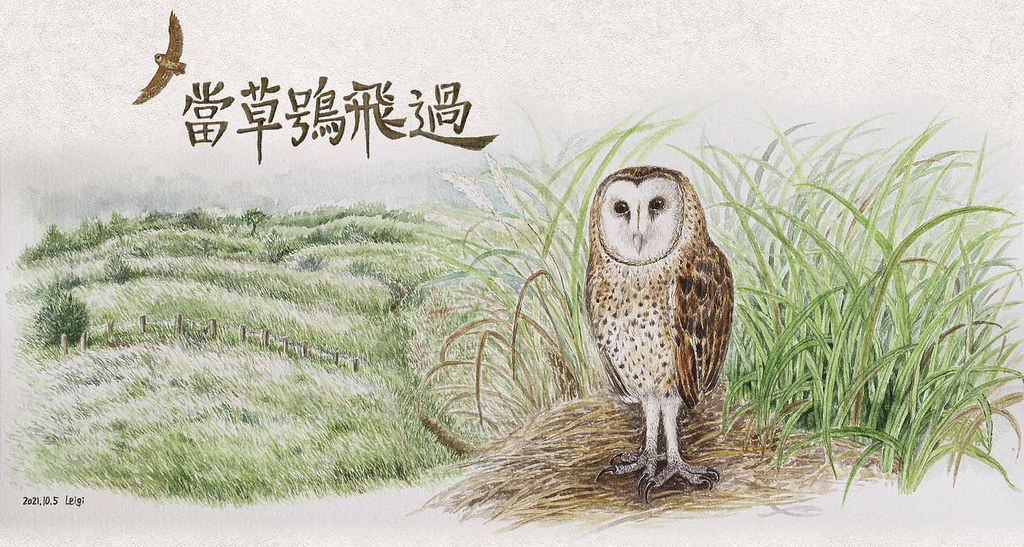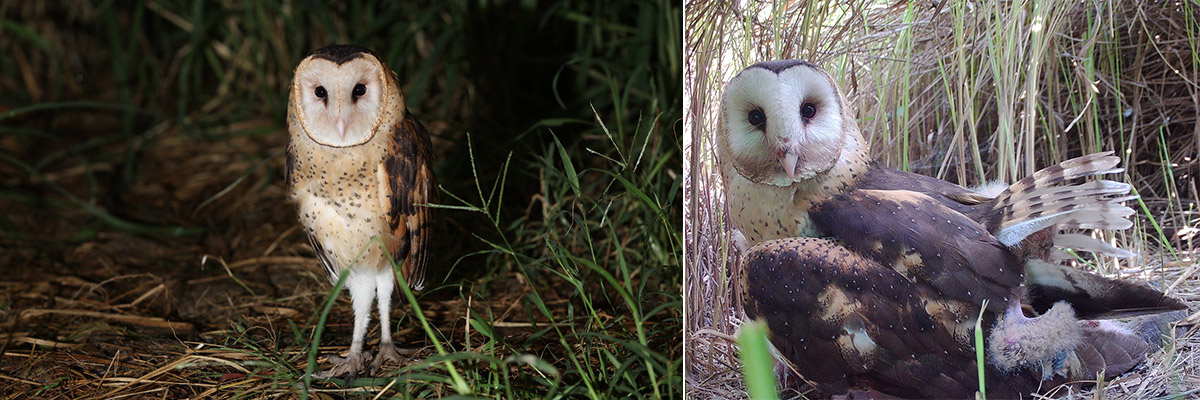
When the grass owl flies, and night descends, maybe you are enjoying a meal with family and friends, or curled up on the couch watching shows alone, or flipping through a book as the day gets darker. Not far from the window, perhaps a grass owl is silently flying by... The resting places for grass owls could be in farmlands or grazing lands, maybe it is a small patch of abandoned land on the side of the road or a corner of an industrial area, Or it is a military shooting range, grasslands surrounding the airport, or the high riverbank of the river. But no one can see it.
 It is so close but yet so far for us
It is so close but yet so far for us
Why does it seem like grass owls live among us but we are oblivious to their existence. Looking through old newspapers from no more than 50 something years ago, residents of Kaohsiung accidentally captured two grass owls when logging. Not only could the public not identify the bird, even the media used the temporary name of “strange bird.” Even now, many members of the public are unaware of the grass owl’s existence. However, this mysterious species may face extinction and disappear before we can get to know it.
The grass owl is the only resident bird that lives in grass fields out of the 12 known owl species in Taiwan. During the day when people are active, they are hiding in tall bushes and sleeping. They only show themselves after sunset and people have gone home.
In order to better adapt to nocturnal activities and hunting mice and rats, the grass owl’s body is highly specialized. For example, the concave shape of its face, which looks like half an apple, highly concentrates sound. The slight height difference between their two ears creates minute differences in the time for sound to reach their ears, which helps them to accurately find the location and distance of their prey. In order to strike without a sound, the front edges of its feather has evolved into a zigzag pattern so that air can pass through naturally without making any turbulent sounds.
However, they are extremely picky when it comes to the environment for reproduction and habitat. They do not like grass that is too tall or too law, too dense or too thin. They prefer tall grass measuring around 100 centimeters, making Baimao grasslands the perfect choice. Their reproductive season goes from October to March they lay three to five eggs each time. When building a nest and nurturing the next generation, grass owls will abandon their nests if the danger is too great.
Although they have a cute appearance, grass owls are predators by nature and sit on top of the food chain. Their only natural enemy is the are humans.
Humans are the Largest Threat to the Survival of Grass OwlsIn Taiwan, grass owls mainly reside in grasslands on plains or low hills from Chiayi to Pingtung. When they hunt, they tend to visit the farmlands surrounding their habitat. Estimates are there are 300 to 500 grass owls left. This population of this rare animal is also decreasing annually, classifying it as a class 1 critically endangered animal, just like the leopard cat and Taiwanese black bear.
Since their habitats and hunting grounds have a high degree of overlap with areas inhabited by humans, three main threats to their survival have surfaced and they are all linked to human behavior: rat poison, bird-catching nets, and land development in grass owl habitats.
Rat poison Grass owls mainly feed on rats and mice, so is common for them to be poisoned to death by eating poisoned rodents. In 2011, the Kaohsiung Wild Bird Society found multiple dead owls in grass owl habitats in Qishan and Yanchao. In 2016, they found a nest with the dead mother bird inside. The four fledglings in the nest were nowhere to be found. The Kaohsiung Wild Bird Society sent the body of the mother bird for testing and found three types of rat poison in its body. Among which, two reached lethal doses for the raptor.
Bird-catching nets Currently, bird-catching nets are not used to catch grass owls. The purpose of the nets is to ensure aviation safety (prevent collision with birds) and they are installed in military airports. The nets are also installed on farmland to prevent loss of crops. However, the grass owls, who mainly live in the grasslands and farmlands, are often accidentally caught in the nets, causing injury and deaths.
Habitat destruction Since the grass owl habitats are on plains and around low hills, areas with the greatest threat due to development pressure, the grass owls may easily go extinct due to the loss of habitats. Starting in the early days, as human population grew, towns and cities were built, farmlands were cultivated, and various projects were constructed. In recent years, the return of overseas Taiwanese businesses has exacerbated the pressures of developing industrial zones and there are potential threats from future opto-electronic developments.
Although grass owls are equally as endangered as leopard cats and Taiwanese black bears, they receive less media exposure and are often ignored because of the public’s unfamiliarity with this animal. Through this project the Taiwan Environmental Information Center hopes to interview scholars, researchers, central government departments and local governments, the NGOs documenting grass owl nest locations and rescuing injured grass owls on the frontline, and the local Siraya people. The aim is to identify the dangers that grass owls face, the efforts we have made, the ongoing research and conservation work, and possible directions for future efforts. In the past, the Siraya people co-existed peacefully with the grass owls amongst the bushes and grass plains. Today, when the grass owl flies, we hope to do more for them.
Supporting biodiversity is a long-term goal of the Wistron Foundation. In 2020, we used practical actions to support the National Geographic production of Night Hunters: Taiwanese Grass Owls, to protect the less than 500 Taiwanese Grass Owls. Just like the care for the grass owls shown in When the Grass Owl Flies, we invite you to watch the film and share in the care for the survival of the grass owls, while supporting biodiversity through co-existence with all species!
(Article: Chu Wei-Jun (reporter of the Taiwan Environmental Information Center); illustration: Ling Li-Chi; photo: Tseng Yi-Shou, NPUST Bird Ecology Lab. Authorized by the Taiwan Environmental Information Center for print)
Complete report on When the Grass Owl Flies Night Hunters: Taiwan Grass Owls watch online



 中
中